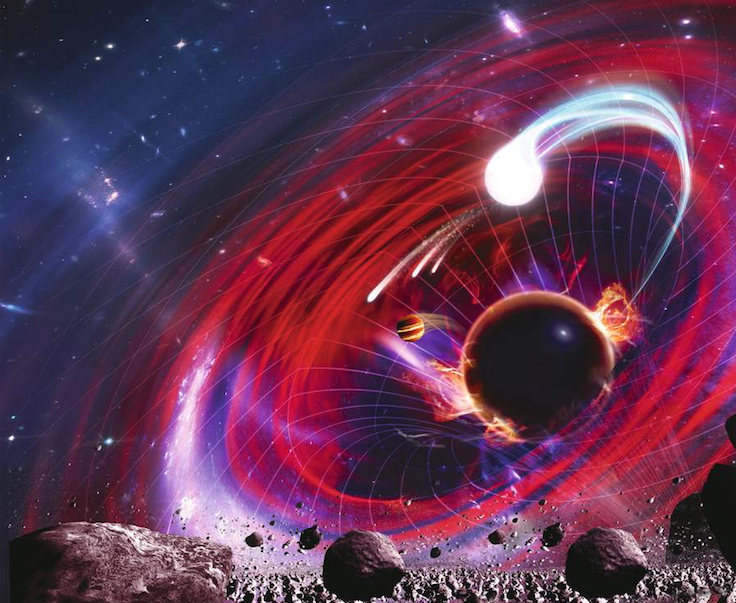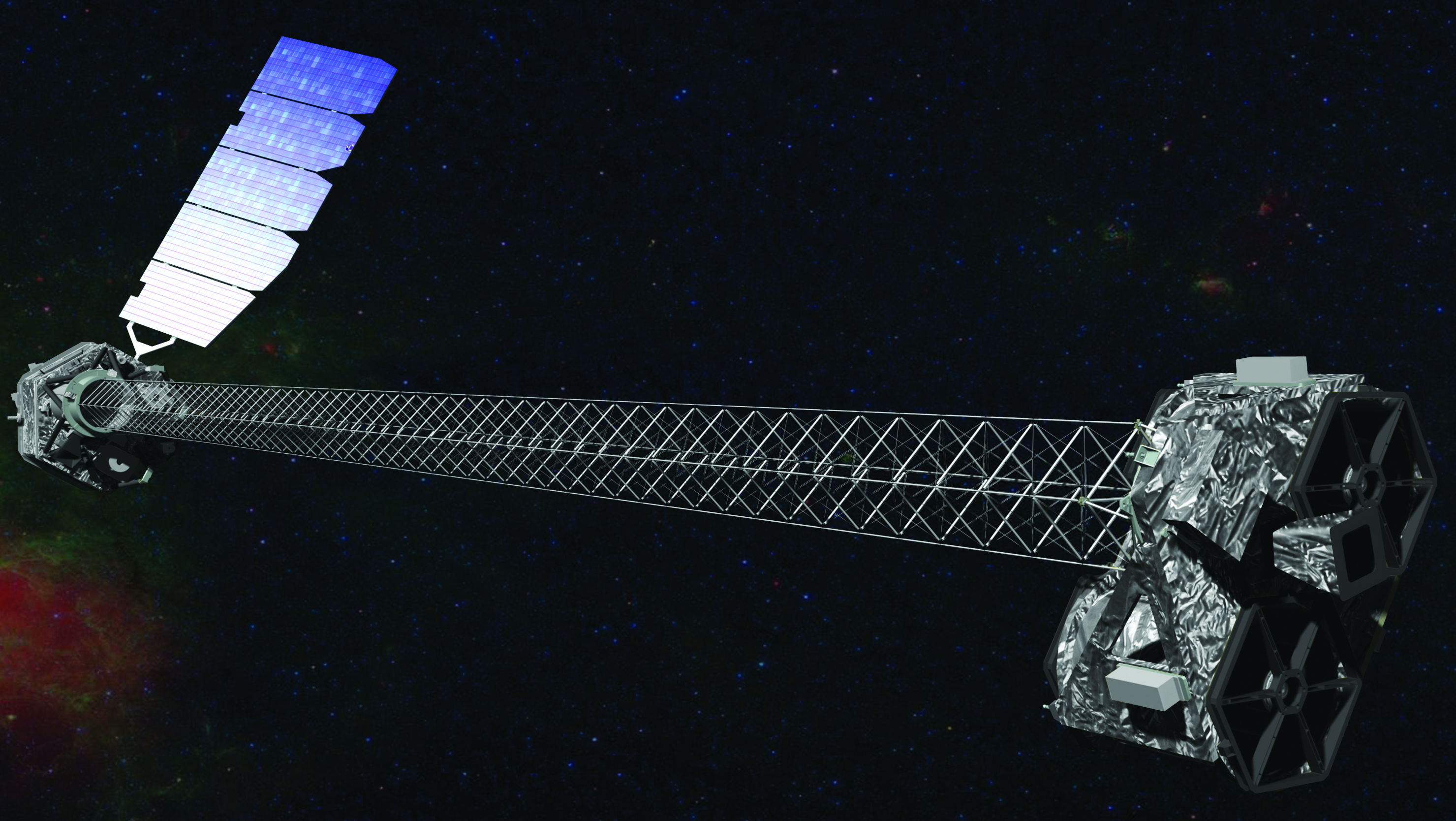How to detect black holes
by Scott Dutfield · 10/04/2019

Discover the mysterious world of black holes and the projects trying to capture them
Black holes are some of the most impressive and strangest astronomical oddities in existence. But, complex as they are, it was Albert Einstein who first predicted their presence back in 1916 with his theory of General Relativity. However, it wasn’t until 1967 that astronomer John Wheeler coined the name ‘black holes’, a rather precise moniker given that not even light can escape one.
Galactic giants
Born from the death of a star, stellar black holes are created by the collapsing of a star’s mass and are the smallest form of black hole. Just as our Sun does, stars convert hydrogen into helium during nuclear fusion at their core. The radiation caused by this reaction pushes against the star’s gravitational forces, which push inwards. As long as there is a balance between the radiation and gravity, the star will remain as it is. However, as that radiation reduces over time, the fight against gravity also decreases. Eventually the gravity of the star forces its mass to fold in on itself, creating a stellar black hole, the resulting singularity around 30 or more times the mass of our Sun. Though stellar black holes are pretty big, there are others that make them look tiny.
At the heart of galaxies are supermassive black holes. With the mass of more than 1 million Suns, these black holes are true galactic giants. While their origins are unclear, some suggest they are the result of the collapse of massive clouds of gas during the formation of the galaxy.
What is particularly interesting about supermassive black holes, and something scientist are keen to study, is its event horizon. The point at which nothing can escape the gravitation pull of a black hole, this border casts a ‘shadow’ over the black hole. For example, using a pen, draw a circle on a piece of paper. How do you see the circle on the page? The ink is revealing a circle, the same way as the event horizon reveals a black hole. At this point of descending infinite gravity, time itself is effected by the black hole’s gravity. Black holes, however, don’t act like a vacuum cleaner sucking up stardust but more a deep well into which objects irretrievably fall.
Currently, the existence of a black hole as we know it is theoretical. The reason we know these masses exist is because of the way stars and light act when one is nearby. Monitoring stars’ positions in the universe, scientists can record the way they orbit a potential black hole. Observing X-ray emissions from black holes has also proven to pinpoint these holes, but it can only get you so far without actually seeing them directly. So how do you catch a glimpse of one?
Peering into the unknown
Three projects have come together to form the world’s biggest array of radio telescopes and hopefully produce the required image resolution. The Event Horizon Telescope (EHT), sister project Global mm-VLBI Array (GMVA) and The Atacama Large Millimeter/submillimeter Array (ALMA) have turned the Earth into a planet-sized telescope. They will focus their attention on the compact radio source at the centre of the Milky Way. Known as Sagittarius A*, this is thought to be the location of a supermassive black hole, with the equal mass of around
4 million Suns.
Using a technique called very-long-baseline interferometry (VLBI), the array of telescopes are linked together in order to pickup the astronomical radio sources in space. Objects in space emit different radio waves and radiation, including black holes. The radiation can help produce an image: not of the black hole itself, as that would be impossible, but of its event horizon and the accretion disc that encircles it.
As a star, planet, or any matter in any form, crosses the path of a black hole, the sheer magnitude of the hole’s gravitational pull will devour it. A meal eaten so aggressively will only leave small bits of debris behind. The dust, gas and plasma that remain are held orbiting a black hole in what is known as the accretion disc and fire vertically to form relativistic jets. This is where the production of electromagnetic radiation and light is generated and shot out of the black hole. When the collision with a star produces a vast amount of energy and light it is known as a quasar. This enormous event allows the array of radio telescopes to detect the radiation, locate the event horizon and finally form a picture of a black hole’s shadow.
This planetary collaboration started collecting data in April of this year, and with the last results coming from the South Pole at the end of the year, we could finally see the first image of a black hole at the beginning of 2018.
A picture is worth a thousand words
Taking an image of a black hole will do more than simply show us what a black hole looks like: it could solidify the theories surrounding the phenomenon.
Einstein’s theory of General Relativity describes gravity not as a force but as a curvature of space-time. As a result of his theories, Einstein concludes the shape of a black hole is spherical, while others have suggested the shape to be ‘squashed’. It may seem strange to be concerned with the shape of a black hole, but the shape directly correlates to the way the black hole works and how we view space-time.
Imagine a tightly stretched piece of lycra, pinned at each end, with a weighted ball in the middle. This is how we currently view the workings of black holes and space-time by way of general relativity. The denser the mass of the black hole (in this case the ball) the more it affects the lycra (representing space-time). By knowing the shape and mass of a black hole we can better understand the space-time around it.
Theoretical physicist Stephen Hawking also proposed the idea that black holes emit radiation from their mass, sinking the hole and eventually leading to its total evaporation. By imaging Sagittarius A* the EHT can determine its shape and size and the decreasing factors of a black hole. This could cement or adjust these theories and allow us to gain a better understanding of the universe we live in.
It appears that alongside the remains of stars, a multitude of unanswered questions circle black holes, but by catching a glimpse of one scientists could start answering them.
Record breakers
V616 Monocerotis
Currently existing 3,000 lightyears away, this stellar black hole is between nine to 13 times the
mass of the Sun.
GB 1428
The radiation from a black hole’s relativistic jet had been detected
from as far as 12.4 billion
lightyears away.
Unnamed
Found in the galaxy NGC 1277, 250 million lightyears away, this supermassive black hole’s mass is 17billion times that of the Sun.
XTE J1650-500
Estimated to have a mass of around five to ten times that of our Sun, JT650 is 24 kilometres in diameter.

A spy in the sky
The Event Horizon project isn’t the first attempt to form some sort of image of a black hole. Launched in 2012, the NuStar Telescope was the first telescope sent into space with the ability to focus on high-energy X-rays. This enabled researchers to identify the presence of a black hole but not capture an image of one. By detecting high-energy X-rays, NuStar can paint a picture of the location of a black hole and show the level of radiation coming from it. The telescope has helped us understand merging galaxies, the structure of black holes and the results of their destructive force. Data collected has helped to form an image of key points in the life of a black hole, from its birth by a dying star to its devouring of a buffet of mass forming an energetic quasar. Five years on, the telescope is still spying on the universe and producing some extraordinary visuals.
This article was originally published in How It Works issue 105
For more science and technology articles, pick up the latest copy of How It Works from all good retailers or from our website now. If you have a tablet or smartphone, you can also download the digital version onto your iOS or Android device. To make sure you never miss an issue of How It Works magazine, subscribe today!




